VII. Aggression, Hummingbird Style
This story is told in a different format, not because aggression is the norm for hummingbirds, but because the birds have so many creative and hilarious ways to show aggression and defend their perch seat.
Attack – Offensive Tactics Images on this website suggest that only a very small fraction of birds exhibits aggressive behaviors. The best way to explain the vicious attack on another bird is probably: “the spur of the moment” (“temporary insanity”?) or “an opportunist sensing an easy prey”, or simply birds playing. Except for a few bully birds over the years insisting on fighting with all birds in sight, all attacks seem to be isolated and dissipated within a couple of seconds. Even if a bad egg terrorizes the neighborhood for a few hours, the bird would eventually quiet down and not be a repeat offender. This type of “the spur of the moment” is seen in other animals where humans have no explanation on their sudden aggression. Perhaps a bird ate a bad worm, or fell off a tree branch and hit its head, or being attacked by another bird…..etc. Humans may never know.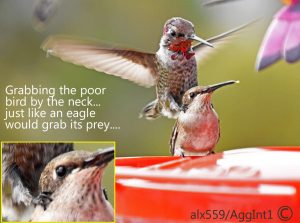

When a bird attacks, it attacks with gusto showing absolutely no mercy. The far right image is a rotten egg grabbing a baby bird by the neck (an easy prey for an opportunist), no different from an eagle grabbing a prey. Talk about super-size attitudes for such a tiny bird! The right image is typical attack from behind (“the back stabbing”) almost always aiming at a bird focusing on eating and vulnerable. Notice the claws of the attacking bird are extended and positioned to stomp. The claws are the weapon next to the beak used for pricking. The orange birds are often the aggressors and the instigators. But sometimes, the orange bird is 
 at the receiving end of a fight (left image). On stomping, it can be brutal (viewer’s discretion advised 😥). This bad egg (image on far left) even grinned for the camera. The victim bird flew away and came back later seemingly unharmed. Another way the birds would get plenty mad and aggressive is when cleaning feeders at the meal time. Some birds would see this action as the utmost offense and would circle around, charging to the maid within inches. The maid would always have to leave quickly and come back quickly with clean feeders.
at the receiving end of a fight (left image). On stomping, it can be brutal (viewer’s discretion advised 😥). This bad egg (image on far left) even grinned for the camera. The victim bird flew away and came back later seemingly unharmed. Another way the birds would get plenty mad and aggressive is when cleaning feeders at the meal time. Some birds would see this action as the utmost offense and would circle around, charging to the maid within inches. The maid would always have to leave quickly and come back quickly with clean feeders.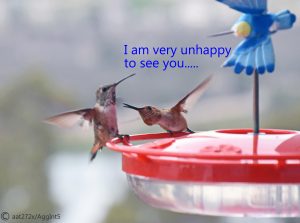
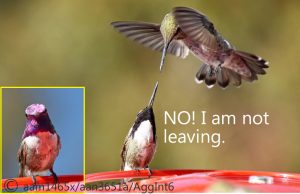
Posturing – Defensive Mechanism Most of the times, the birds are friendly, social and co-existing with a large number of other birds. For such a tiny bird, constant aggression is not a good way to survive and thrive.
The birds are masters of posturing, an effective defensive tool to avoid a fight. For example, the bird would articulate their whole body, the eyes, the beak, the chin, the belly, the wings, the claws….. Everything they’ve got to show disapproval of another bird. That is, everything except getting off the feeder to fight, a lazy bird! This is the “I am very unhappy to see you” tactics. This tactics rarely works. The posturing bird would often end up pretending nothing had happened and continued eating.
 The more common and effective tactics is: “I am not leaving” which requires more work. The birds would plant the claws firmly on the feeder, deploy all parts of body to posture, and then orient the beak and the entire body up towards the incoming enemy in flight. The posturing bird would follow the enemy the entire time with the beaks forming and maintaining a perfect straight-line. The upper left image was a beauty queen purple bird refusing to give up her seat. Another way of fighting is that two birds chase each other to the sky. This is a common scene when the scores cannot be settled on the feeder. No matter how fast the speed, how high they go, or how many times both birds turning their bodies in flight, the birds would most often maintain a straight-line between beaks with incredible acrobatic skills and remarkable consistency. This straight-line configuration is one of the staples of hummingbirds.
The more common and effective tactics is: “I am not leaving” which requires more work. The birds would plant the claws firmly on the feeder, deploy all parts of body to posture, and then orient the beak and the entire body up towards the incoming enemy in flight. The posturing bird would follow the enemy the entire time with the beaks forming and maintaining a perfect straight-line. The upper left image was a beauty queen purple bird refusing to give up her seat. Another way of fighting is that two birds chase each other to the sky. This is a common scene when the scores cannot be settled on the feeder. No matter how fast the speed, how high they go, or how many times both birds turning their bodies in flight, the birds would most often maintain a straight-line between beaks with incredible acrobatic skills and remarkable consistency. This straight-line configuration is one of the staples of hummingbirds.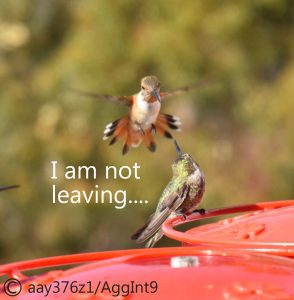
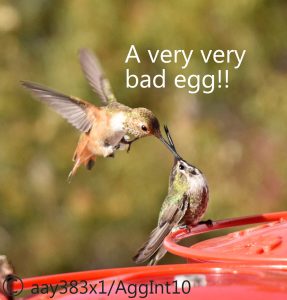
The More Evolved Mathematical Definition of a Straight-Line As it turns out, this ritualistic straight-line is a clever defensive tactics because the straight-line is the longest distance between two birds protecting one from the other coming any closer to cause injury. When a straight-line is breached, or bypassed, it means danger (two right images). Who says humans have the monopoly of mathematical definitions, i.e. “A straight-line is the shortest distance between two points”, is the only interpretation of “a straight-line”. In hummingbirds’ world, it is the longest, and the safest, distance between two birds. This definition is not only correct, but also serves a vital purpose.
With many birds, sometimes hundreds a day in summer time, coming to feeders every day for several years, no birds were found injured, tumbled off from air, or worse. Of course, vicious 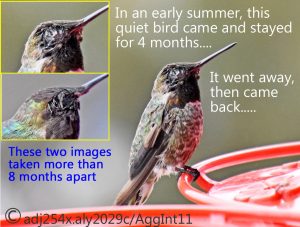 attack does have consequences and injury inevitable. The birds would bravely carry the battle scar to the feeder. The image on the right is a bird with one blind eye. The healed scar seemed to have resulted from injury, but not genetic. This bird was sighted (no pun intended) from time to time for nearly 4 months starting early summer into the fall. This bird was always quiet, alone and sat at the same location of the feeder. It was a surprise to find this bird, and unmistakably the same at the same feeder location, 4 months later in late winter the next year.
attack does have consequences and injury inevitable. The birds would bravely carry the battle scar to the feeder. The image on the right is a bird with one blind eye. The healed scar seemed to have resulted from injury, but not genetic. This bird was sighted (no pun intended) from time to time for nearly 4 months starting early summer into the fall. This bird was always quiet, alone and sat at the same location of the feeder. It was a surprise to find this bird, and unmistakably the same at the same feeder location, 4 months later in late winter the next year.
Hover – This is an effective offensive, defensive and negotiation tactics. There are countless images of exotic hummingbirds with brilliant colors flapping their wings hovering over equally colorful flowers. Studies have shown that given the choice between perching (on a feeder) drinking nectar, comparing to hover-drinking from a flower, the birds would prefer perching and eating. It was attributed to the “decision rule” for expending less energy. Indeed the birds do hover over feeders, and with remarkable persistence. The bird hovers to assess the surroundings, size up potential opponents, or negotiate to join the party. It is a lot of decision-making to: “attack or not?”, “join the party or not?” or “get out of here or not?” See upcoming story and short videos on “Hover, How to Annoy Other Birds”. 
In summary, these images suggest aggression is not the norm for hummingbirds. The birds’ jittery alert nature, their high flying speed, and their love for happy dance may be mistaken as aggression. The images also suggest food is unlikely the cause of attack and fight, because when a fight is initiated, there are always plenty of unoccupied spigots. Rather, the decision to attack a certain target may be based on “opportunity” and the unexplained “the spur of the moment”, and the victory prize seems to be always the perching seat. When a bird fight, it can fight dirty. They are loner birds, particularly the bullies. It is a wide range of personalities as in all living creatures. But in most part, these observations demonstrate that hummingbirds live in a “community” with empathetic pack behaviors. The “community” may be fluid, but nonetheless, it is a community. More often than not, the birds are rarely alone on feeders or on shrub branches. “Getting along” is part of the survival. The birds have evolved defensive mechanisms to avoid a fight. Even in a real fight, the fight is half-hearted and never lasts more than a couple of seconds. To hummingbirds, it is eat-fight-eat-flight and eat some more. Somewhere in there, they also play and dance. It is always win, win and win some more.
VII-A. “I am very unhappy to see you.”
There are several ways for a hummingbird to land on the feeder or a shrub branch. Sometimes, landing can trigger hostility. That is, the perched bird would show total disapproval and articulate their whole body to intimidate, e.g. eyes bulging out of the face, the chin bulging with feathers flaring up, mouth open, neck extended, and sometimes, the wings flapping. This is definitively not a welcome gesture. Even when there is no enemy in sight, still need to practice the mean look. The only problem is that this lazy posturing rarely worked, except getting a lot of laughs from the other bird.
VII-B. “I am not leaving.”
This is the most universal signal. The bird would “sit up”, claws firmly planted on feeder, and head lifted up with beak pointing towards the incoming enemy. There are three outcomes with decreasing frequencies: (a) the incoming bird going to another spigot; (b) a big fight and the perching bird got up and fight, both gone, and (c) the enemy bird chased away the perching bird and occupied the same spigot.
VII-C. “I am not leaving – not my shrub branch seat!”
Despite hundreds of seats on shrub branches, still the occupied seat is the best….
VII-D. Practice Makes Perfect.
Even when no enemy in sight, need to practice the mean look. These are serious birds.
VII-E-a: Bitter Fight on Shrub Branch
Smetimes posturing is not enough, a bird has to get up and fight. In the fight, it is often a dominant bird and a weaker bird. Even in a confined space of shrub branches, birds can fight and do damage.
VII-E-b: Victory Price – the EXACT Branch Seat
These sequential images show that birds fight for the perching seat, not food. This phenomenon is also observed on feeders. The aggressive bird wanted “the seat”. Even though there were hundreds of choices, it was “the seat” that the bully bird wanted.
VII-F: Creative Ways to Deter Enemy
There are other ways of planting the claws on the feeder to deter an enemy. The first 4 frames showed a baby bird simply ignored a bully and the last 8 frames were a group successfully made the bully go away.
VII–G: It is All about THE SEAT in the Restaurant
Almost all the aggression is originated from wanting the same perch position, either on a shrub branch or on a feeder. The first four frames showed a bully bird, after unable to intimidate anyone, decided to join pretending nothing had happened. The last eight frames were two birds approaching the same spigot, had an argument and one bird won the restaurant seat.
VII–H: A Crazy Bird Gone Mad
What ticked this crazy bird off ?
VII-I: Attack as a Sport
There are situations where a bird will do some dancing, some attacking, and then flew away. These behaviors are not foreign to bigger life forms. Notice the spectator birds…always a good show.
VII-J-1: Back Stabbing
One of the most common attack is the “back stabbing”. In that, the victim bird is too concentrated in eating, or too young to know the danger, and the bully bird an opportunist. When this happened, the victim bird often became alerted and flew away, or it could become a fight in air or a later revenge. More often than not, the bully bird would claim the victory seat.
VII-J-2: Back Stabbing – A Brave Baby Bird
Once upon a time, a very brave baby bird resisted bully’s attack for 30 seconds. The bully ended up running away….GO! BABY BIRD!!
VII-K: Front Attack
It is rare a bird will confront another bird from front….but it can become ugly.
VII – L: Anatomy of a Fight
How did a bird on a perched position get into a fight in air? Here are the sequencees.
VII – M: Get up and Fight
When a victim bird is attacked and alerted, it will get up and fight. The fight can be straight-line posturing, but can also be big face-to-face fight with bodily contact and injury.
VII – N: Straight-Line, the Longest and Safest Distance
It is remarkable how two birds maintain a straight-line between their beaks in air. In this situation, it is often one bird is dominant and the other weaker, by their body language. It is even more remarkable that the birds will carry out the fight into the sky by constantly turning and rotating both bodies in high speed in vast sky and yet maintaining a straight-line between beaks.


















































































































































































































































